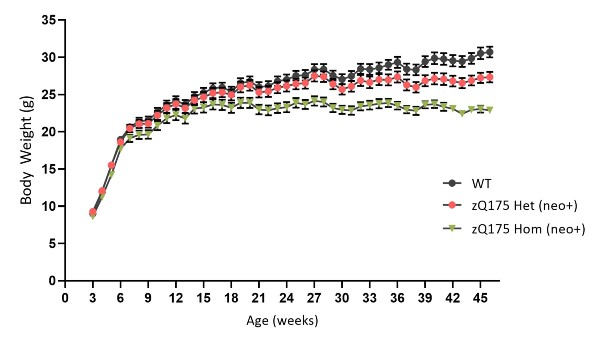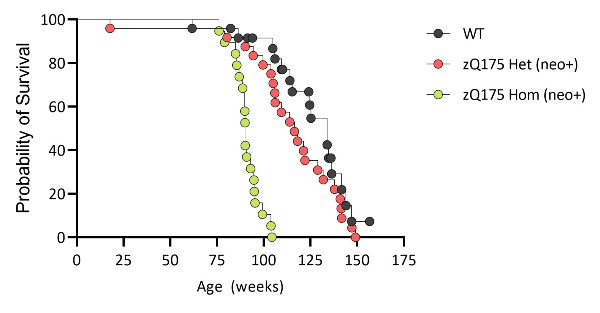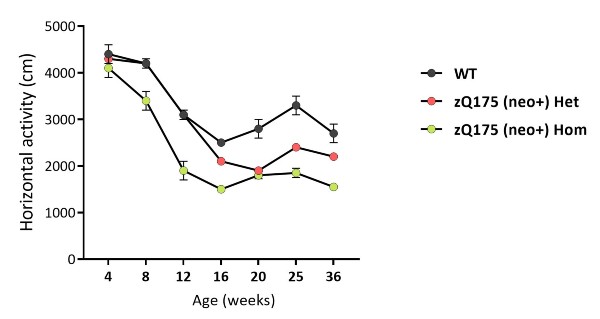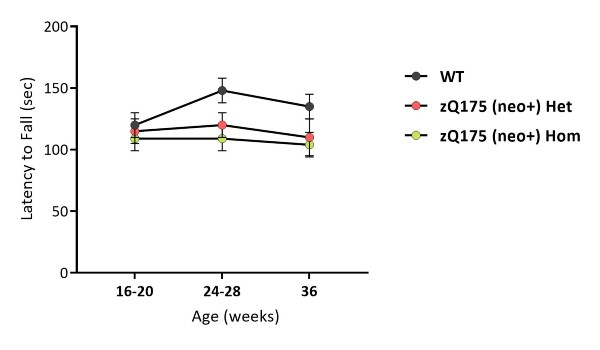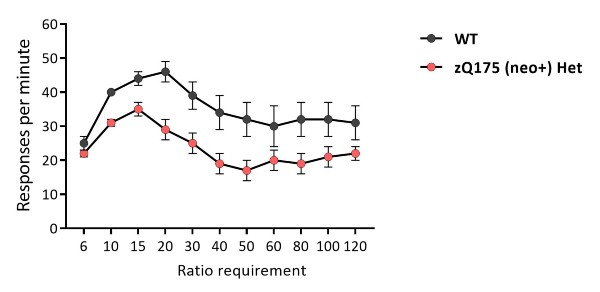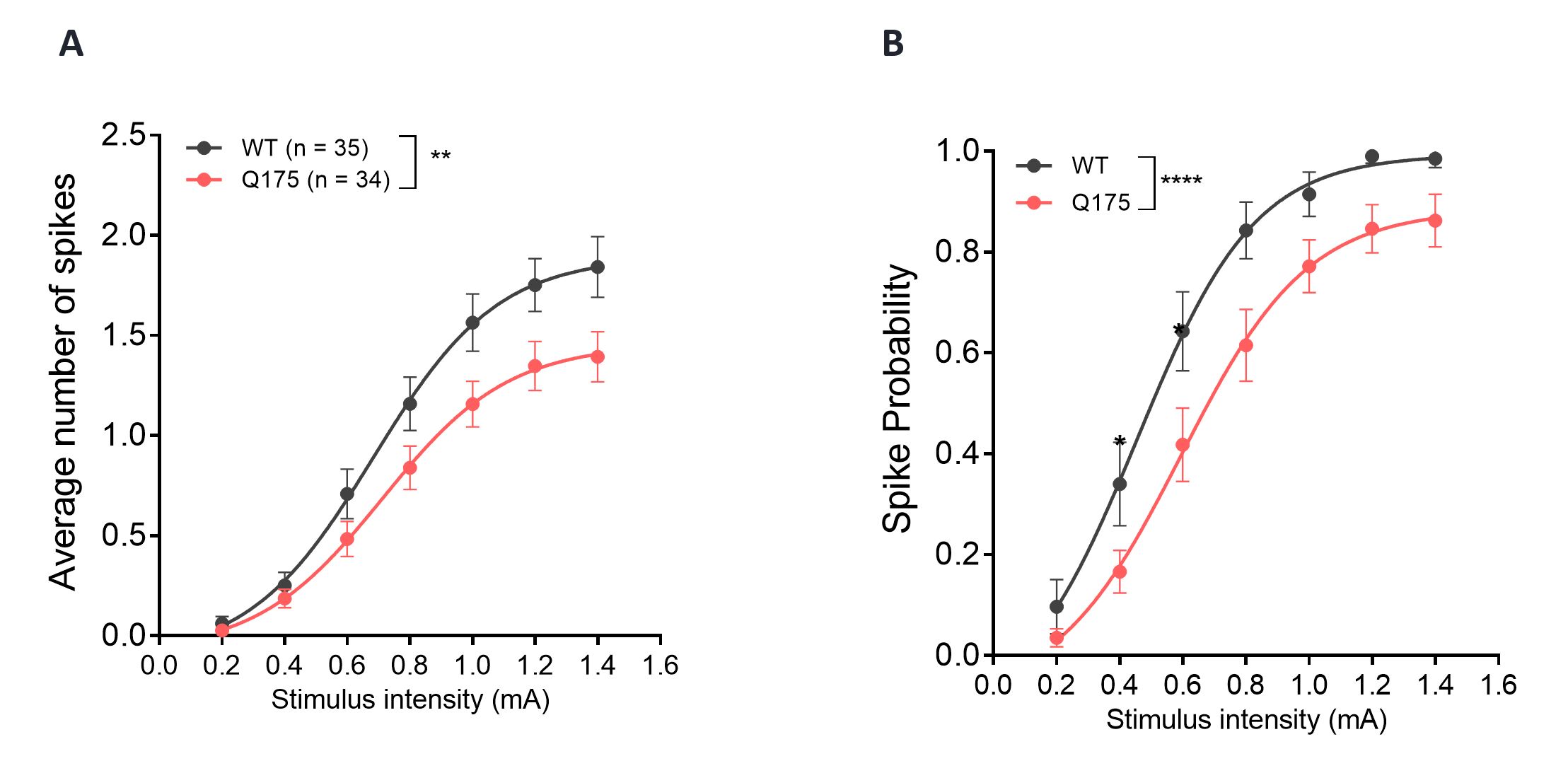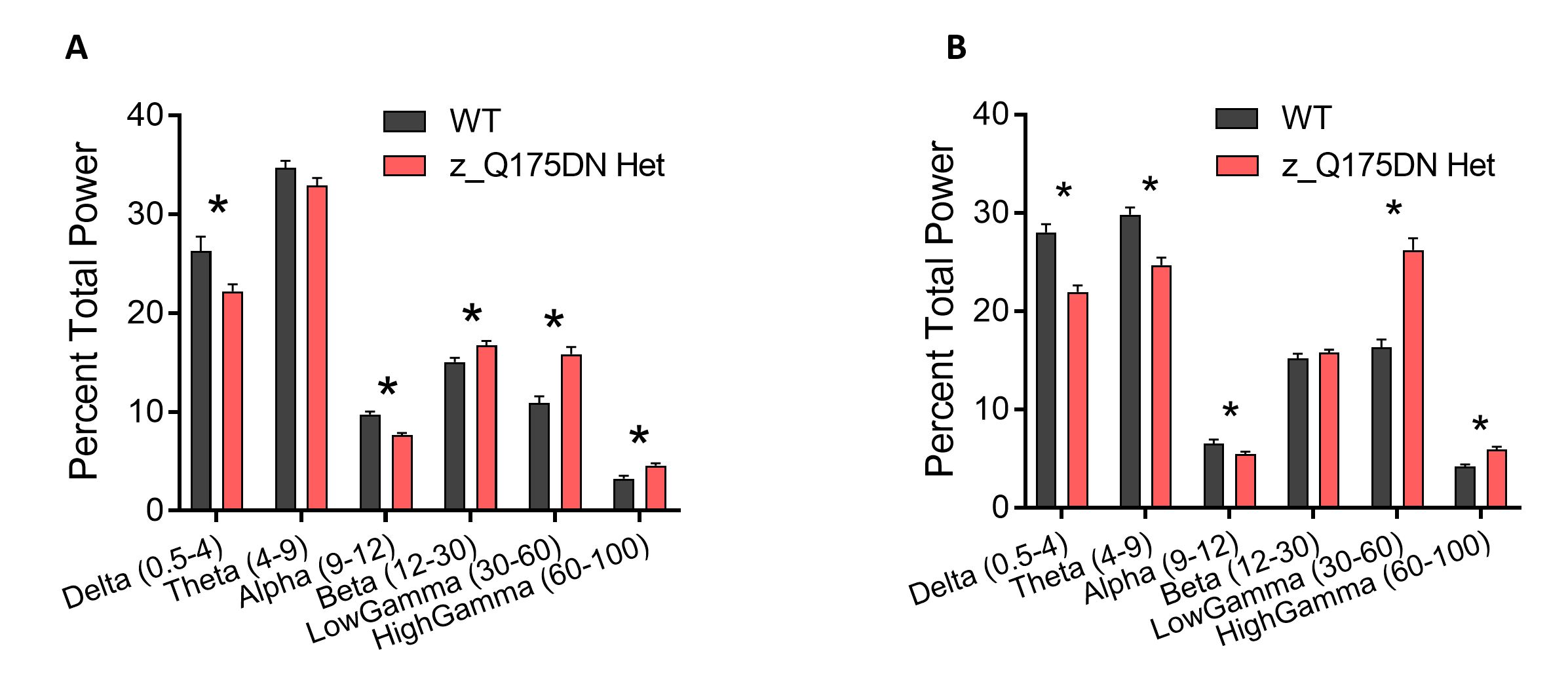Phenotypic Analysis of zQ175 (neo+) and zQ175DN (delta neo) Heterozygous and Homozygous Knock-In Mouse Model
Huntington’s disease (HD) is an autosomal-dominant inherited neurodegenerative disorder that results from an abnormal trinucleotide CAG repeat expansion in the huntingtin (htt) gene. The zQ175 knock-in model of HD, generated with the replacement of mouse Htt exon 1 with the mutant human HTT exon 1, was identified at PsychoGenics. It was obtained by spontaneous CAG expansion in Q140 knock-in mice generated in the laboratory of Dr. Scott Zeitlin. This newer model has ~188 CAG repeats and displays a slow progression of HD-relevant abnormalities such as decreased striatal volume, motor impairment, and basal ganglia circuit abnormalities.
In collaboration with the CHDI Foundation, we employed behavioral, molecular, and electrophysiological analyses to assess striatal dysfunction in the heterozygous and homozygote zQ175 mice. The zQ175 (neo+) knock-in and zQ175DN (delta neo) models of HD can be tracked through CHDI Foundation as CHDI-81003003 and CHDI-81003019, respectively.
Behavioral Assessment in zQ175 Heterozygous and Homozygous Knock-In Mice
The zQ175 (neo+) Knock-in model shows a progressive motor and cognitive decline consistent with other HD models. Specifically, this model exhibits age-related decline in body weight, reduced survival, motor deficits, and apathy, which are more pronounced in zQ175 (neo+) homozygous mice.
Figure 1: Body weight curve from 3 to 46 weeks of age. zQ175 Homozygote (neo+) and zQ175 Heterozygote (neo+) weigh significantly less than WT littermates, with weight loss in the homozygotes starting around 18 weeks of age and 36 weeks of age for the heterozygotes.
Figure 2: Kaplan Meier survival curve. zQ175 (neo+) Homozygous mice demonstrate a reduced survival compared to the zQ175 (neo+) Heterozygous and WT littermates.
Figure 3: Horizontal activity traveled in open field. zQ175 (neo+) Homozygous mice demonstrate reduced locomotor activity as early as 8 weeks of age while the zQ175 (neo+). Heterozygous mice exhibit reduced activity around 16 weeks of age.
Figure 4: Rotarod assessment. Starting around 24 weeks of age, both zQ175 (neo+) Homozygous and Heterozygous mice fall faster from the rod compared to their WT littermates, revealing a motor coordination deficit.
Apathy, defined as lack of motivation characterized by diminished goal-oriented behavior, is a known symptom of Huntington’s disease and other neurodegenerative disorders. A typical and well-controlled assay to probe this domain in rodents is the progressive ratio task, a procedure where food-restricted animals are required to expend progressively increasing effort to obtain successive food reinforcements.
Figure 5: Progressive ratio task. The zQ175 (neo+) Heterozygous mice demonstrate a significant reduction in the response rate in the progressive ratio task. The response rate (lever press for a reward) is a measure of an animal’s willingness to earn a reward as the ratio of responses to rewards increases. The heterozygous mice have significantly lower response rates indicating reduced interest in the reward or apathy.
Progressive Downregulation of Striatal mRNA Transcripts in zQ175 Heterozygous Knock-In Mice
Figure 6A-E: Quantitative PCR (qPCR) analysis of striatal tissue from zQ175 Het (neo+) at different ages (WT in gray; zQ175 Het (neo+) in red). Relative levels of target genes (A: Drd1=D1 receptor, B: Darpp32= Dopamine- and cAMP-regulated phosphoprotein 32 kDa, C: Drd2=D2 receptor, D: Pde10a=cGMP phosphodiesterase 10A, and E: Cnr1=cannabinoid receptor 1) were normalized by the geometric mean of housekeeping genes (Gapdh, ATP5b, Elf4a2) and then normalized to the 6 week old WT average (n=24 6-week old mice; n=10-12 per age for ages 12-46 weeks).
Hyperexcitability in Direct and Indirect Pathways in Dorsal Striatal Spiny Projection Neurons (SPNs) in zQ175 Heterozygous Knock-In Mice
Figure 7. Analyses of intrinsic membrane properties in direct versus indirect pathway SPNs using whole-cell patch clamp electrophysiology in brain slices. Brain slices were prepared from zQ175 Het (neo+) mice expressing green fluorescent protein (GFP) under the control of Drd2 promoter. Indirect pathway SPNs in the dorsal striatum were visually identified as positive for GFP, while direct pathway SPN was identified as negative for GFP. (A and C) Elevated membrane resistance and reduced rheobase current in both direct (gray bars for WT, red bars for zQ175 Het) and (B and D) indirect pathway SPNs (gray bars for WT, green bar for zQ175 Het) were apparent in 6-month old zQ175 mice.
In Vivo Electrophysiological Recording Revealed Altered Corticostriatal Functional Connectivity In zQ175 Heterozygous Mice
Figure 8. In vivo single unit recording from anesthetized 6-8 month old zQ175 (neo+) knock-in mice (labeled as Q175). A) Decreased action potential number and B) spike probability was observed in the zQ175 Het mice across a range of stimulating intensities (p <0.01 for panel A; p<0.001 for panel B). (Figures adapted from Beaumont, V. et al (2016) Neuron.)
Reduced Delta/Alpha Paralleled by Enhanced Gamma Oscillations in Striatum and Cortex Of zQ175DN Heterozygous Knock-In Mice Measured By In Vivo EEG
Figure 9: EEG power spectrum analysis show a decrease of oscillation activities in low frequency bands and an increase of oscillatory activities in higher frequency band in both cortex (A) and striatum (B) of 6 to 10 month old zQ175DN (or zQ175 Het neo minus) mice during WAKE state. Bar graphs show the percentage of total power of different frequency bands in (A) frontal Cortex (ECoG) (Left) and (B) striatal local field potential (Right) during WAKE stage.

